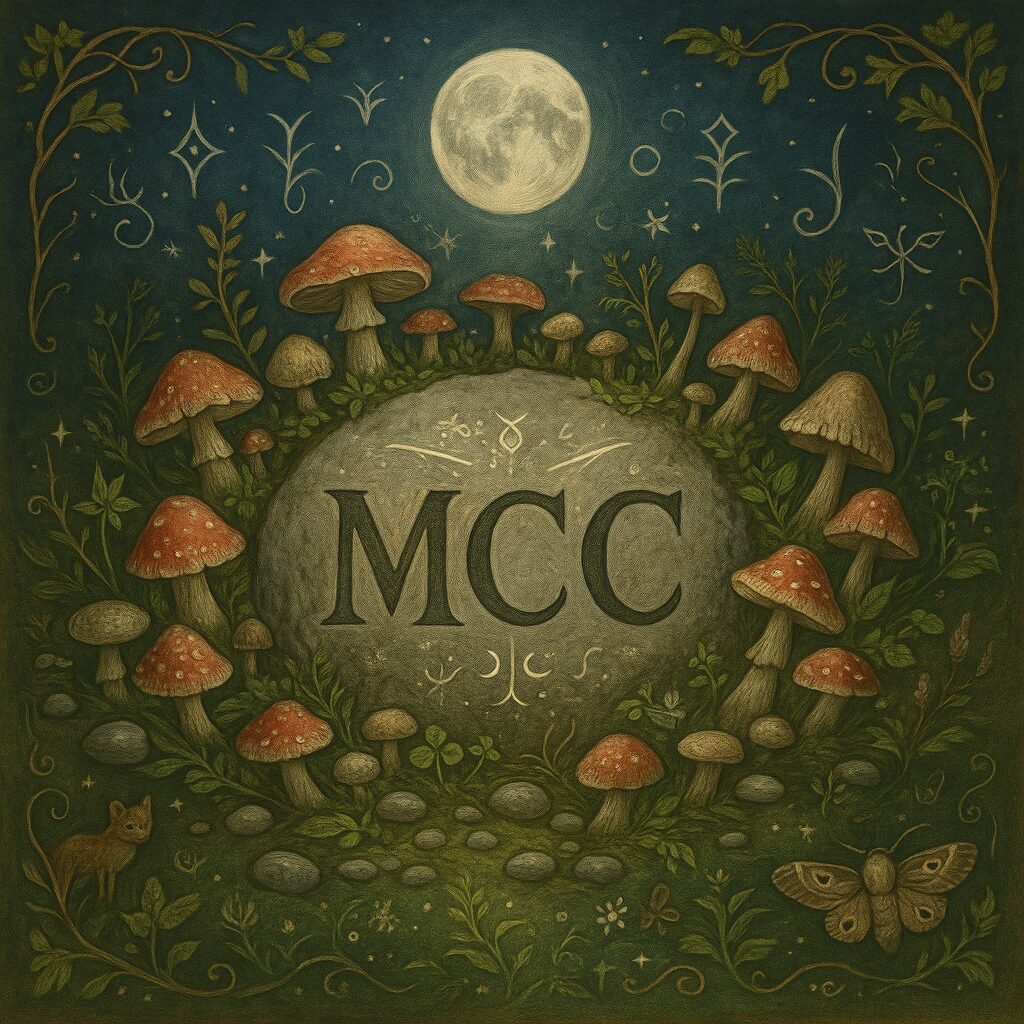Veiled Radiance: Esoteric Lunar Traditions and Spiritual Growth
For as long as humans have looked upward, the moon has returned our gaze—not as a passive orb, but as a living mirror of mystery. Across European folk traditions, the moon is not merely a celestial body but a being of rhythm, revelation, and retreat. She rules tides, dreams, fate, and flowering. She governs the breath of magic and the soft silence of intuition. In the old stories, the moon sings the language of fairies, seduces herbs into bloom, and offers light only to those who know how to see in shadow.
Today, within covens and solitary circles alike, the esoteric lunar path is a spiraling journey of spiritual growth and magical refinement. These traditions draw on folkloric roots that predate the printed word and live still in whispered rituals, moonlit fields, and behind the eyes of witches who dare to remember.
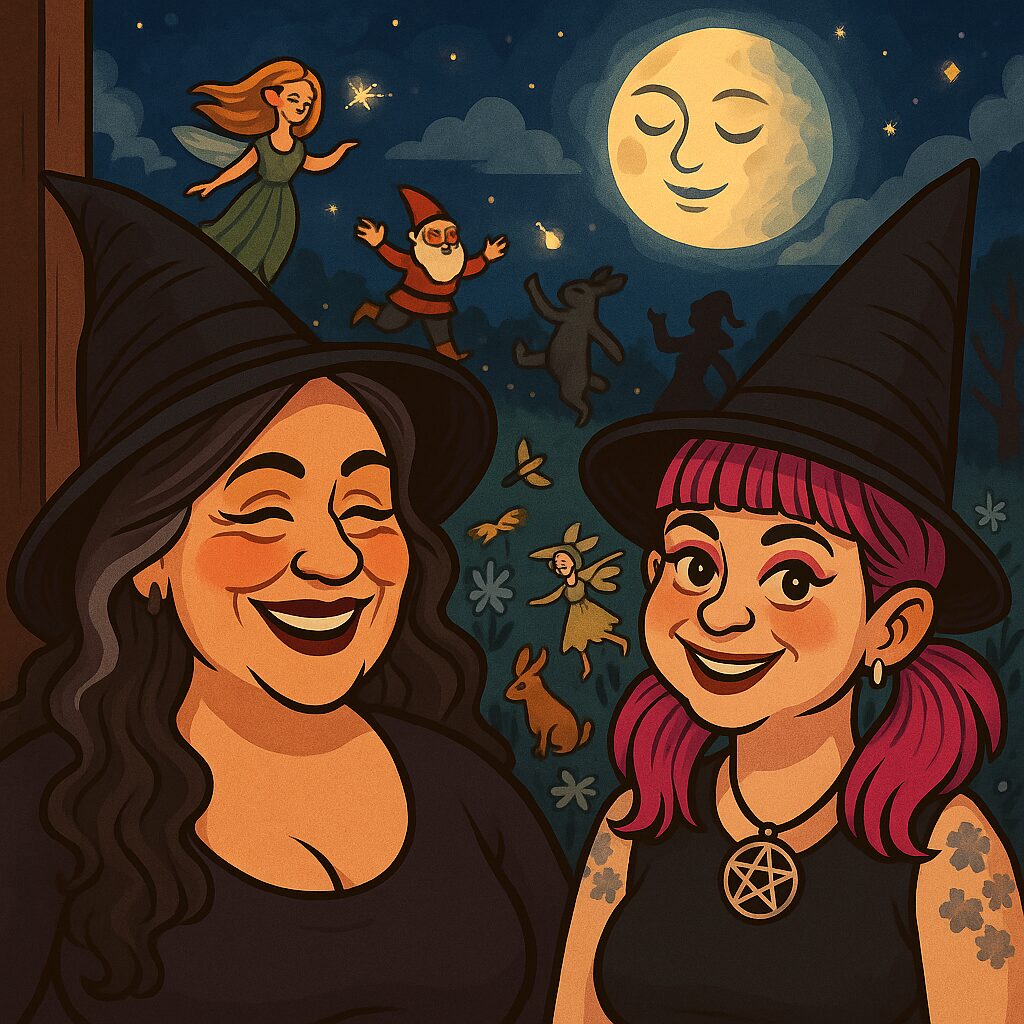
In European folklore, the moon was personified and deified by many names. To the Greeks, she was Selene, luminous and adorned with a silver chariot; to the Romans, Luna, ever watchful from her pale throne. The Slavic Zorya sisters and the Norse Máni were celestial timekeepers, while the Celtic world revered the moon in relation to goddesses such as Arianrhod, Branwen, and Rhiannon, each weaving fate, justice, and regeneration through the lunar spiral.
Ronald Hutton, in The Triumph of the Moon, notes that pre-Christian Europe held the moon as “a ruler of time and tides, and a bearer of hidden power.” Within peasant folkways and cunning-craft practices, lunar phases marked times for gathering herbs, casting spells, and entering communion with the spirit world. The dark moon was feared but potent; the waxing moon hopeful and bright; the full moon—well, that was the hour when the veil shimmered thinnest and most wild.
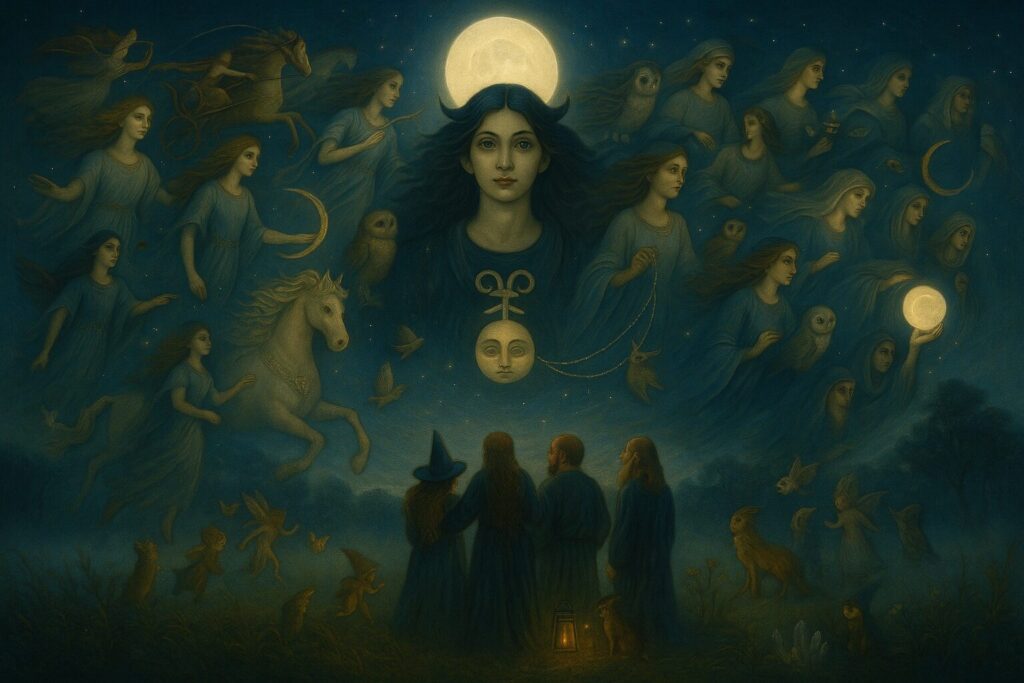
Many esoteric practitioners, like Doreen Valiente, placed particular emphasis on the Esbat—a ritual working tied to the lunar cycle, distinct from the eight Sabbats. Valiente described the Esbat as “a time to work magic…whereas the Sabbat is for celebration.” That dichotomy remains core: the moon is the witch’s clock, compass, and secret window.
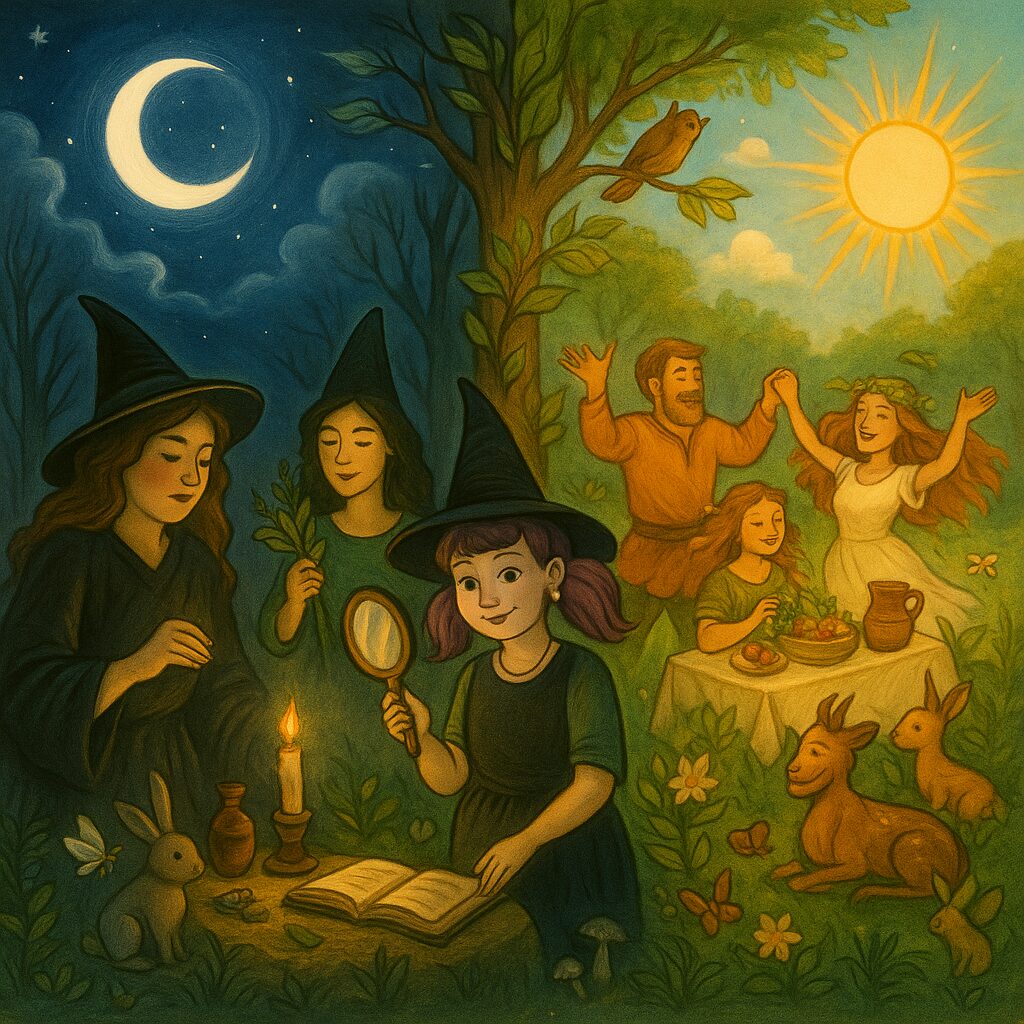
The moon is not a moment. She is a movement.
She does not arrive; she reveals. She teaches not through constancy, but through return. To walk with her is not to follow a straight line but to spiral—inward, outward, again and again—until you are both lost and home.
As the moon begins her ascent from darkness, you feel it in your bones before you see her light. The waxing crescent slips across the horizon like a promise: thin, curved, fragile—and yet utterly sovereign. It is a time of initiation. The world around you breathes possibility. The soil stirs. Your hands itch to begin again.
You gather herbs, tie thread around candle glass, whisper intentions beneath your breath. You speak aloud to the seeds of your life—not for who they are now, but for who they could become. Spellcraft here is an invocation, a rising spiral.
This is the domain of the young witch in you—the one who dares, who casts forward without needing proof.
In ancient folk tales, the waxing moon was when the solitary sidhe danced in clearings. They left rings of mushrooms or opened star-like blossoms only under silver light. To see them was to be invited—but only if you brought honey or silver, and only if you asked nicely.
The moon grows. So do you.
She becomes full—not just in shape, but in power. Her face stares down, luminous and exacting, revealing what you have built. This is the moon of mirrors. You cannot hide here. Every hope, every fear, every line of your incantation is made visible.
This is the Esbat. This is the working. This is the night your magic listens back.
You stand in the circle. Or you sit by your window. Or you kneel beside water, feeling the light vibrate along your spine. You speak her name—or your own—and the energy comes like a wave. She meets you fully, not as judge but as reflection. In that gaze, you are whole.
Under the full moon, the trooping fae emerge—the courts of fairy kings and queens, traveling their own spiral paths through the hollow hills. Irish lore tells of mortals who danced with them, returned blessed with second sight—or did not return at all. Magic under the full moon is rarely safe. But it is always honest.
You see your path. You see what stands in its way. The time for release approaches.
The moon begins her waning—a descent, a hush. Her light thins. Your attention turns inward. Spells become looser, smoke-filled. You burn things now. Letters, regrets, bits of paper with names scrawled in haste.
This is the midwife’s moon—the one who helps you end things with dignity. You banish what clings too tightly. You call back what you have scattered. The herbs you used to gather are now smudged into ash.
This is the moon for unbinding, for boundary work, for the slow and sacred art of letting go.
In folk tradition, this was the time when village healers performed smoke rites to clear illness and spirits alike. The hedgerows became the site of walking—not in body, always, but in spirit. The hedgewitch leaves her home and steps between the worlds. You leave, too. Not physically. But something in you breaks and reforms.
Then, the moon vanishes.
Her body becomes dark—not absent, but unseeable. Here, at the bottom of the cycle, is the threshold. It is the moon of grief. Of unmaking. It is not a time for spectacle. It is a time for stillness so profound it could be mistaken for silence.
You dim the lights. You draw the curtains. The room becomes an altar of absence. You write your sorrow on black paper. You dissolve it in water. You whisper to ancestors who no longer answer with names.
There is no magic to perform here—because you, yourself, are the spell being undone.
In the oldest lore, this was the night the witches flew—not on brooms, but on breath. They became wind, became smoke, became the thing that couldn’t be caught. Inquisitors feared these nights not for what witches did, but for what they were—limitless, unseen, elemental.
The Unseelie Court, it was said, stirred on moonless nights. Fae without allegiance, beings of shadow and chaos, moving across the fields. Witches hung rowan charms and salted their thresholds. Even power has its cost.
You rest. You retreat. You vanish into yourself.
And then… a sliver. The new moon rises—not yet visible to the world, but felt in the gut. You sense her before you see her. This is not rebirth. Not yet. It is the whisper before the breath, the flicker before the flame.
You set a seed in soil. You close the journal and put your fingers to your lips. You speak no spell, but the air crackles as if one was spoken.
There is a power in not-knowing. There is magic in the pause.
And the spiral begins again.
In every phase, the moon gives you a different face, a different tool, a different truth. She does not demand consistency. She invites presence. Her power is not in her light, but in her movement. Her beauty is not in fullness, but in return.
You walk with her—not behind, not ahead.
With.
And so you learn:
That gathering is as sacred as release.
That silence is as holy as song.
That you, too, are a cycle.
Not a moment.
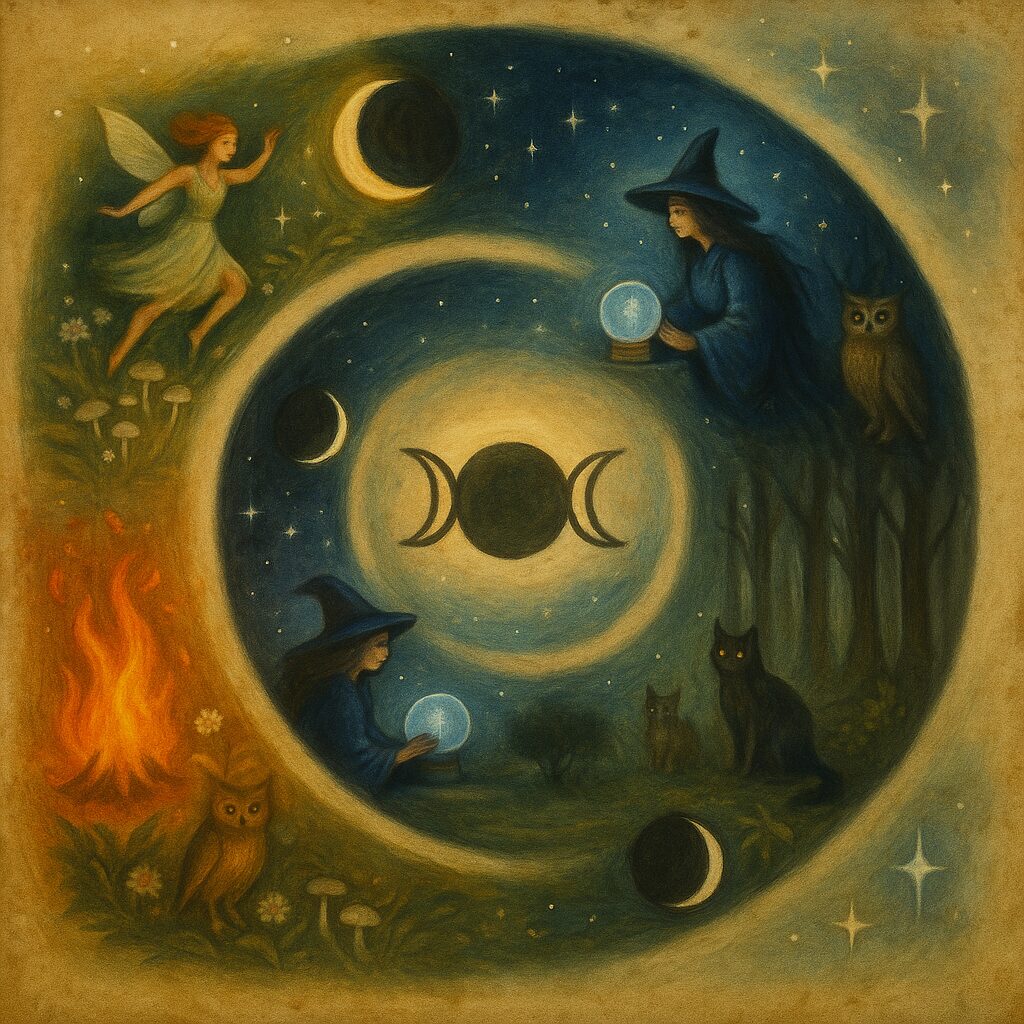
Lunar rites take many forms within the coven, from simple meditations to complex rituals. While no Esbat is ever identical, many include:
- Circle Casting: Often done beneath the moon’s rays, invoking the lunar spirits and land guardians.
- Divination: Using tarot, runes, or moonwater scrying. The full moon’s light is believed to amplify intuitive sight.
- Offerings: Honey, milk, or white flowers for the moon or local spirits—left near oak groves, old stones, or fairy mounds.
- Chants and Moon Names: Each full moon has its folk name—like “Wolf Moon” or “Harvest Moon”—used to shape ritual intention.
In some covens, an Esbat may follow a “shadow path,” where each member walks the circle alone and speaks a truth they haven’t dared say aloud. These are intimate, transformative rites where the moon’s reflection reveals not just spellwork, but soulwork.
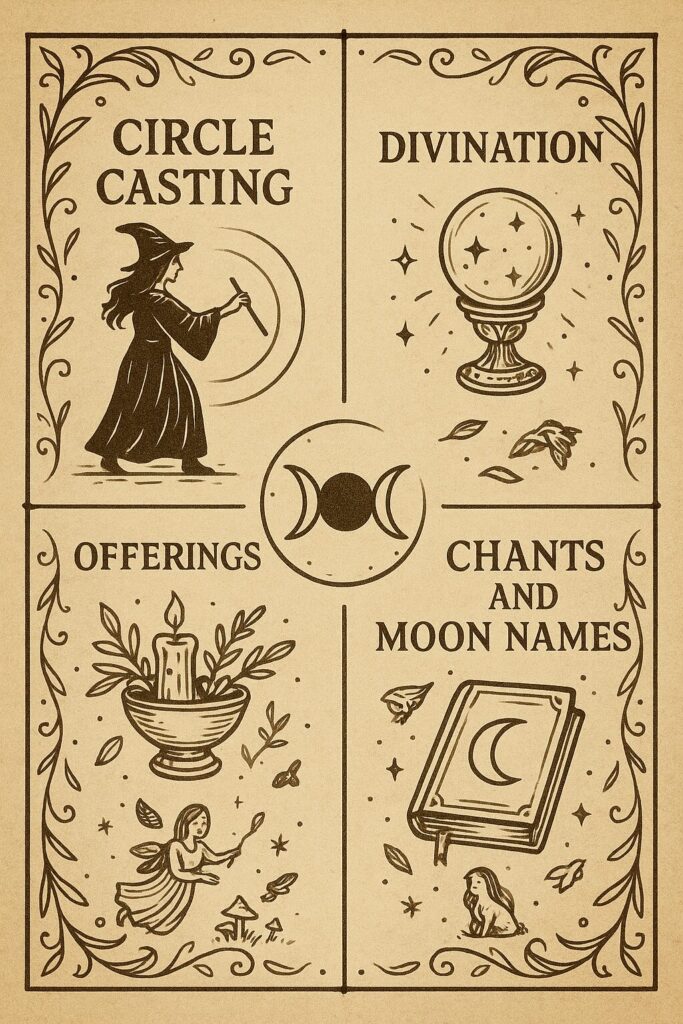
The moon has long been associated with the feminine, but the moon is not only for women. Male, trans, and nonbinary witches are equally drawn to lunar rites. As many contemporary practitioners remind us, lunar current flows through all. Máni, the Norse moon god, glides across the sky as a watchful brother; Thoth in Egyptian tradition links lunar knowledge to writing, thought, and ceremony.
Within My Cousin’s Coven, we recognize that every seeker stands under the same moon. Whether you move with her cycles, howl with her phases, or cry in her dark, she meets each of us where we are.
To walk a lunar path is to join a lineage of seekers, whisperers, and wise folk. Every moon phase offers not just magic, but meaning. Esbats are more than rituals—they are conversations between soul and sky.
As the poet Sappho once wrote: “When the moon rose… the stars were hidden in her light.” So too are our small selves eclipsed in the glow of becoming.
If you have ever gazed up and felt the pulse of something ancient, something quiet and stirring—you are already a part of this circle. Lay your offerings, light your candle, and step into the moon’s embrace.
She has been waiting.
